Book Review: “The Atlas of Unbuilt Architecture” — Alarming and Inspiring Visions of “Castles in the Air”
By Lisa Reindorf
These designs serve as a forceful testament to the endless possibilities of architecture, to the imaginative power of engineering.
The Atlas of Unbuilt Architecture by Sam Lubell and Greg Goldin. PHAIDON, 368 pages, $150.
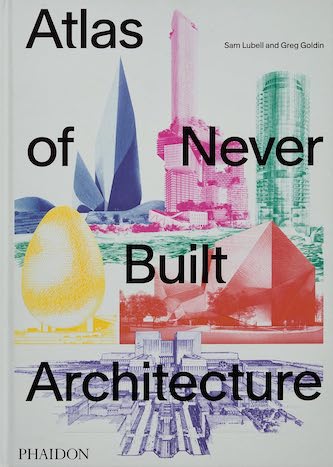 Imagine how different our built environment might look if money and politics or engineering and cultural constraints didn’t affect what was built — where the only real limit would be the imagination of the architect. Sam Lubell and Greg Goldin’s The Atlas of Never Built Architecture is a fascinating excursion into that fantasy scenario. It is a compendium of unrealized architectural visions — buildings and other structures that were designed but never went beyond the drawing board.
Imagine how different our built environment might look if money and politics or engineering and cultural constraints didn’t affect what was built — where the only real limit would be the imagination of the architect. Sam Lubell and Greg Goldin’s The Atlas of Never Built Architecture is a fascinating excursion into that fantasy scenario. It is a compendium of unrealized architectural visions — buildings and other structures that were designed but never went beyond the drawing board.
A glass robot in Mexico, a sci-fi hotel in Machu Picchu, a pyramid in Tokyo, and a birds nest in San Diego. The eye-popping projects in this book are architectural dreams that were just too challenging, too expensive, or just plain too weird to be constructed.
“That a building could become anything tangible — be it remarkable or despicable, banal or glorious, revolutionary or preposterous — despite not being built,” write the authors,” “is a testament to the fact that buildings are much more than simply concrete, stone, timber, and glass. They are foremost a collection of ideas, but also of stories, struggles, cultures, and fateful circumstances — materialized, or not, in built form.”
The writers take readers on a journey through a collection of extraordinary proposals crafted by renowned architects from the early 20th century to the present day. It turns out that all kinds of buildings never get built: skyscrapers, museums, art galleries, churches, bridges, hotels, casinos, opera houses, and housing.
These architectural projects never became realities, but they offer an illuminating tour of the extraordinary range of world-shaking ideas and visions architects have dreamed up. How would our towns and cities look if we had the nerve and resources? What kind of awe-inspiring structures would dot our landscapes? A vast array of images in The Atlas of Unbuilt Architecture — from sketches and drawings to digital renderings — suggest what such a landscape would look like. The selected architects have come up with some astonishing, sci-fi-inspired designs that — for better or worse — remain in the realm of the conjectural..
Looking at the decades of unbuilt projects featured in the book invites a range of reactions, from “Oh, that would have been spectacular!” to the regret that these wonderful additions to our architectural canon, if built would have raised the bar regarding beauty, innovation, or environmental value.
Finnish architect Alvar Aalto, known for his organic architecture and use of natural materials, had several projects that never materialized. His design for the “Guggenheim Helsinki” museum, envisioned in the ’40s, was a stunning example of his signature naturalistic style. The building’s undulating forms, contoured to fit into the surrounding landscape, strove to create a harmonious relationship between nature and architecture. Unfortunately, lack of resources derailed the project.
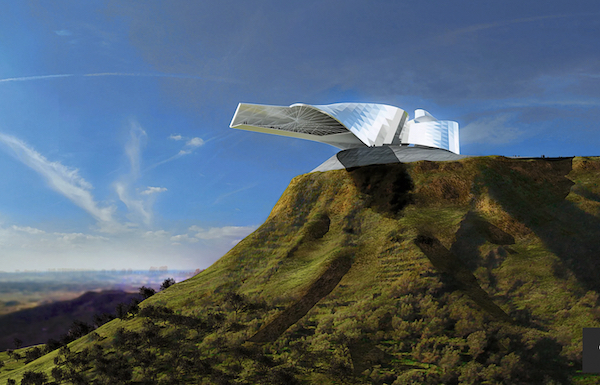
Art Museum Strongoli, Coop Himmelblau, Strongoli, Italy, 2009. Photo: ISOCHROM.com
Another museum, Museum Strongoli, was conceived as a cantilevered structure clad in silver sheathing. Perched on a hilltop in Calabria, Italy, this building was designed by Coop Himmelblau in 2006. It was conceived to be a destination attraction in the groundbreaking mode of the Guggenheim in Bilbao. But, like many projects in the book, the project faced numerous challenges, both politically and environmentally. The local population found the vision to be too radical. On top of that, the engineering and construction costs rendered the plan financially unfeasible.
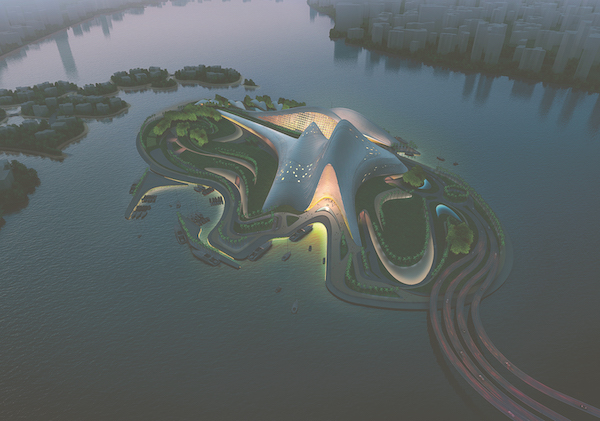
Dubai Opera House, Zaha Hadid, Dubai, United Arab Emirates, 2007. Photo: courtesy of Zaha Hadid Architects
Zaha Hadid’s “Dubai Opera House” in the UAE, with its flowing, organic forms surging out of the landscape and unusual use of materials, reflected her innovative spatial approach. The complex would have contained an opera house, a theatre, art galleries, a performing arts school, and a hotel. Unfortunately, the crash of the global economy in 2008 put the kibosh on this structure.
Another radical conception: Norman Foster’s “Crystal Island” which would have been located in Moscow, a design for an enormous mixed-use development. This colossal, transparent dome-like structure was designed to cover an entire city. Would it have revolutionized urban living with environmentally positive features enhanced by forward-looking technology? Or would it have been a dystopian nightmare? We will never know, because logistical and financial hurdles ensured that it did not venture beyond the drawing board.
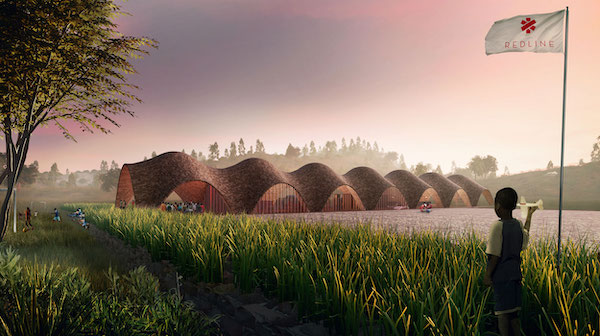
“Droneport, “Norman Foster Foundation, Rwanda. Photo: courtesy of Norman Foster Foundation
Not every project was designed to inspire awe. Some were designed to solve serious problems, such as access and affordability. Slated for Africa, “Droneport” was conceived to be a model for ideal building construction in remote areas. A war reporter, Jonathan Lagarde, conceived of the notion; architect Norman Foster designed what it might look like. They were simple structures built out of a minimal kit of parts, unloaded from a storage crate dropped by a drone. This would be a relatively cheap means of constructing communal buildings and much-needed shelter for remote locations. Production could easily be scaled up. Sadly, this promising idea was not taken up.
A number of the unbuilt architectural projects in the book were prescient, including Bing Thom’s design for a Chinese Art Museum in Vancouver British Columbia. His concept was to bury the museum underground. Undulating rooftops serve as part of a park on the surface. This eco friendly, forward thinking plan would have required less energy consumption and would provide a sensible use of the land. Alas, it was too expensive to be built at the time.
Other projects were probably better off remaining unbuilt because of ideological, aesthetic, or environmental reasons. The Machu Picchu Hotel, designed by Peruvian modernist Miguel Rodrigo Mazuré in 1969, was a sci-fi inspired design that featured projecting wings and windows on the undersides of its hallways. But the fantastical edifice would have completely overwhelmed its site. Positioned adjacent to a 15th-century Inca world heritage site, the hotel would have been gruesomely inappropriate. Political turmoil, perhaps fortunately, prevented it from being realized.
Le Corbusier, a pioneer of modern architecture, also had his share of unrealized projects. His “Plan Voisin” for Paris, proposed in 1925, was a radical urban redesign that called for the demolition of a large portion of the city– to make way for high-rise buildings and open spaces. At the time, it was considered an admirably utopian vision. Of course, if the plan had been implemented it have destroyed the elegant historic that Paris we love. In retrospect, it is fortunate Le Corbusier’s modernist deconstruction was shelved.
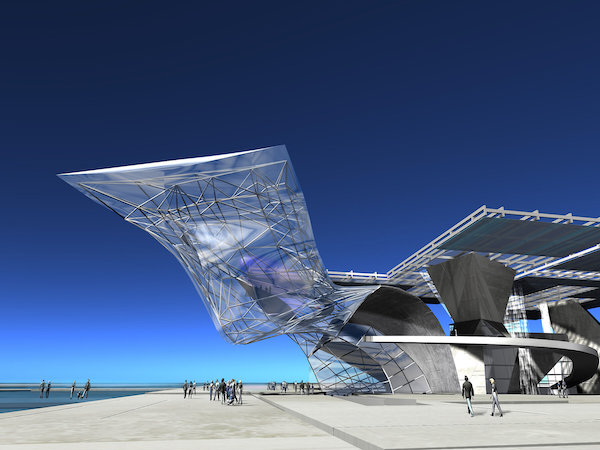
Coop Himmelblau’s design for JVC Entertainment Center in Guadalajara, Mexico. Photo: ISOCHROM.com
Other projects fit in the ”too weird” category: Coop Himmelblau’s JVC Entertainment Center in Guadalajara, Mexico. It was a dream of a rich Mexican businessman, a complex that would contain multiple offices, cinemas, and recreation spaces. The proposed futuristic structure — glassy and multi-cantilevered structure looked like a giant robotic creature in renderings. It is perhaps better for the location that it wasn’t constructed, at least in that bizarre incarnation. A much simpler conventional design went ahead instead.
Other designs, while unbuilt, have inspired future buildings. For the design of the San Diego Stadium in 1963, American architect Charles Luckman and Mexican architect Felix Candela came up with a conical shaped building whose structural skin was made of diamond webbing. The roof was engineered out of radiating tension cables, which was structurally and visually innovative at the time. Although the stadium was never built, it could have been one of the influences on the iconic “birds nest” stadium built for the 2022 Beijing Olympics.
The Atlas of Unbuilt Architecture does more than present an extraordinary range of ideas that have shaped the built environment; it also offers a unique perspective on the creative process. Some readers may view the projects in the books as missed opportunities; others may be relieved they were never built. But these designs serve as a forceful testament to the endless possibilities of architecture, to the imaginative power of engineering. As design and construction explores new ideas, it is educational to look back at these ‘castles in the air’ as innovative possibilities yet to be realized.
Lisa Reindorf is an architect and artist whose work deals with climate change. She lectures frequently at art and environmental conferences, and is also an arts writer for such publications as Hyperallergic and Miami New Times.

Fascinating! This review makes me want to read more.